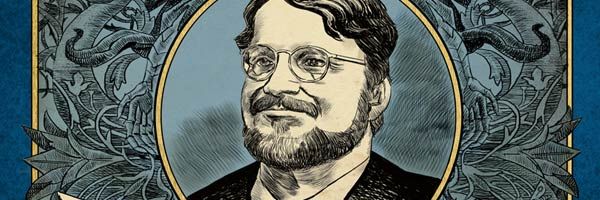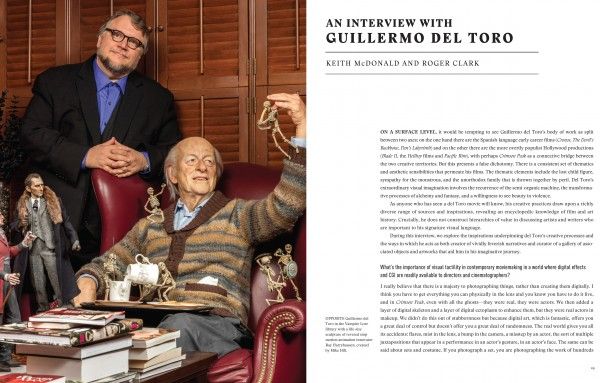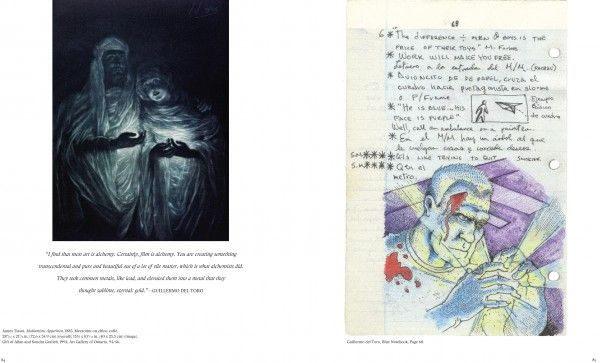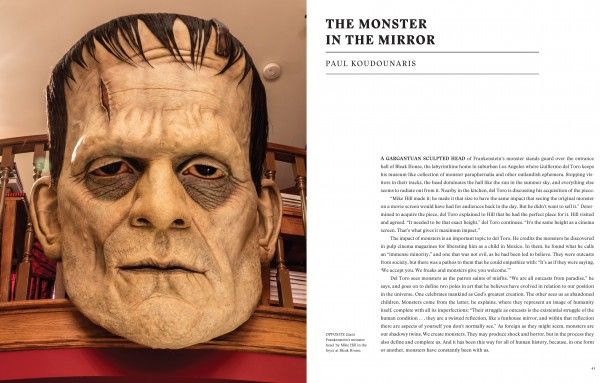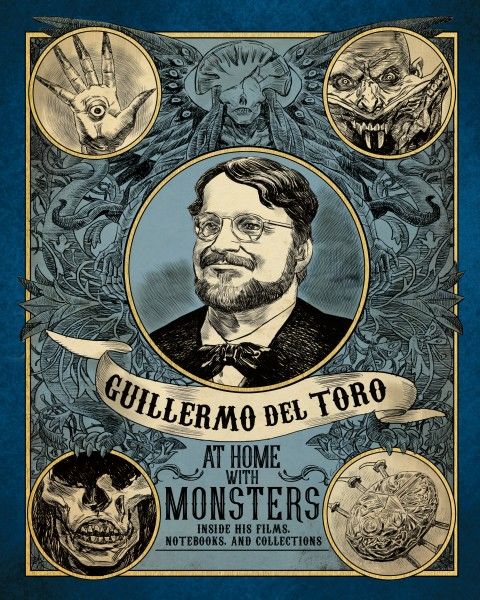Guillermo del Toro is surely one of the most imaginative storytellers of our time. In terms of visualizing the impossible, del Toro’s mind knows no limits, whether it’s bringing to life a haunting child ghost in The Devil’s Backbone or giant mecha in Pacific Rim. His ability not only to dream up the various creatures and worlds we see on screen, but also actualize them, is tremendous, which makes him all the more fascinating as a person. What, exactly, goes on in that brain of his? What drives him? Why is he so fascinated with monsters? Why are we, as audience members, so receptive to his work?
Answers abound in the fantastic new book from Insight Editions, Guillermo del Toro: At Home with Monsters, which is being released on August 30th in concert with the new art exhibit of the same name that opened at the Los Angeles County Museum and will be making its way to the Art Gallery of Ontario and the Minneapolis Museum of Art in short order. If you’re unable to attend the exhibit yourself, this book is the next best thing—and even if you are, it’s a great companion with wonderful insight into the mind of del Toro and his creations.
At Home with Monsters is filled with art selections curated by del Toro himself, pages from his own journals, a revealing in-depth interview, and plenty of commentary from notable figures in the art world including Britt Salvesen, Jim Shedden, Paul Koudounaris, Keith McDonald, Roger Clark, and Guy Davis. The commentary covers everything from deep dives into the art that inspires del Toro, to an engrossing anthropological chronicle of monsters in art throughout human history.
In a foreword to the book, del Toro explains his fascination with monsters as something far more meaningful than a simple hobby:
“Monsters are, to this day, true family to me. They are not effigies collected for profit or due to a completest mania. In Bleak House, I have built a temple to them, and within them I have built devotional shrines. I serve them—a power greater than myself—with abandon and unwavering dedication and love.”
Del Toro’s love of fantasy began at a young age, spurred by frustration with adults who would look down upon the fantasy genre as silly and childish, and used as an outlet for creativity or immersion when the real world came crashing down. Throughout At Home with Monsters, del Toro’s devotion to fantasy and monsters is well covered, albeit from an academic standpoint. Indeed, the book begins with a look at del Toro’s massive collection of props, art, figures, etc., exploring the dichotomy between a museum-like approach to said collection and a personal accumulation of oddities. Del Toro is at once preserving fine art while also hoarding totems of the bizarre or strange for personal value. He, like many, feels at home when surrounded by the “outcasts” of society as opposed to the picture-perfect faces that have been deemed “beautiful.” Is Frankenstein’s monster not just as beautiful as Helen of Troy? Who’s to say beauty does not also encompass the non-traditional? There is beauty in monsters, to be sure, and this book dives deep into these sorts of philosophical questions that drive much of del Toro’s work.
Scattered throughout At Home with Monsters are a variety of photographs from del Toro’s own collection, which offer a close look at the vast array of oddities del Toro has acquired—and curated—over the years. If you’ve ever heard the stories of “Bleak House” and desired to trek there, thumbing through this book is the next best thing, as it gives glimpses of del Toro’s Haunted Mansion room, H.P. Lovecraft statues, and much, much more.
The centerpiece of the book, however, is an extensive interview with del Toro conducted by McDonald and Clark. The filmmaker touches on everything from how the rise of digital and CGI has affected his work to his favoring of fan art over studio-crafted marketing campaigns for his films—as he astutely points out, “Crimson Peak was entirely mismarketed in the sense of it being a really good campaign for a horror movie, with the tragic exception that it was not a horror movie!” Del Toro also explains his approach to color, which is a vital aspect of his films and serves to accentuate the thematic drive. Crimson Peak and Pacific Rim, he says, are his two most carefully color-coded films he’s ever made, with tremendous attention paid to how each and every color was chosen for both movies.
Del Toro is happy to cite the vast array of influences on his work, and At Home with Monsters dives deep into these with separate sections devoted to innocence and childhood, Victoriana, magic and the occult, movies and pop culture, and of course Frankenstein and horror. Indeed, much time is devoted to the Frankenstein story, which is as big an influence as any on del Toro both as a person and as an artist. The tale of man’s most formidable foe being a creation of man himself—and a misunderstood one at that—speaks directly to the thematic drive of much of del Toro’s work.
Basically, if you’re a fan of Guillermo del Toro and want to know what he loves, and more importantly what makes him tick, Guillermo del Toro: At Home with Monsters is a must-buy. Even for anyone who just loves horror or monsters, or art for that matter, it proves to be a fascinating read and a feast for the eyeballs. This is art geek heaven, full stop.

